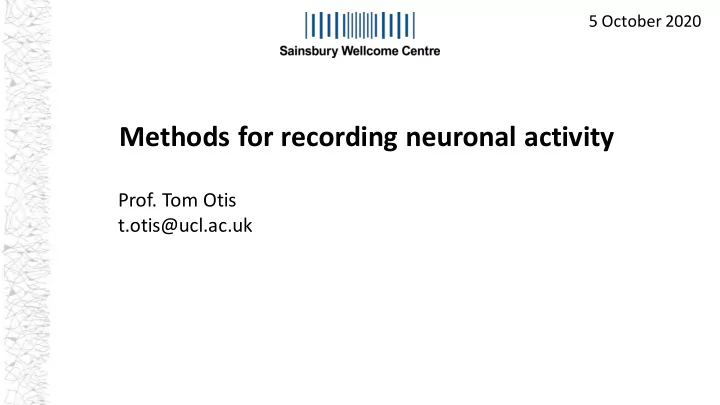

5 October 2020 Methods for recording neuronal activity Prof. Tom Otis t.otis@ucl.ac.uk
From ‘animal electricity’… to how nerves work Galvani, 1780 Galvani, 1791
Helmholtz’s measurements of nerve conduction velocity Devices to measure time intervals: Claude Pouillet’s bullet velocity device, 1844 Helmholtz’s design for measuring nerve conduction velocity, c 1848 Hermann von Helmholtz from Schnmidgen, Endeavour , 26:142 (2002)
Willem Einthoven’s string galvanometer Willem Einthoven
First electrical recordings of a nerve impulse frog sciatic nerve Herbert Gasser Joseph Erlanger American J. Physiol., 1922
First recordings of light-evoked activity in optic nerve Conger eel optic nerve Lord Edgar Douglas Adrian J. Physiology, 1927 "I had arranged electrodes on the optic nerve of a toad in connection with some experiments on the retina. The room was nearly dark and I was puzzled to hear repeated noises in the loudspeaker attached to the amplifier, noises indicating that a great deal of impulse activity was going on. It was not until I compared the noises with my own movements around the room that I realised I was in the field of vision of the toad's eye and that it was signallingwhat I was doing."
Mechanism of the nerve impulse Squid giant axon Alan Hodgkin Andrew Huxley Nature, 1939
Hodgkin Huxley model of the action potential http://nerve.bsd.uchicago.edu/ Fig.1 Fig.4 Hodgkin, Huxley, and Katz, J. Physiol., 1952
Intracellular measurements with a microelectrode Ag/AgCl wires are standard in physiological contexts due to their excellent bidirectional ionic mobility, stability instrument The Axon Guide, 3 rd Ed.
Microelectrode methods for intracellular recording ‘sharp’ microelectrode 3 M KCl, 3 M K Acetate 80-100 M 10 microns whole-cell patch pipette physiological internal e.g. 130 K MeSO 4 2-5 M 10 microns
Patch clamping from Purves et al, Neuroscience 5 th Ed. 2012 https://youtu.be/M3xN4Ihmt7U
Microelectrode methods for intracellular recording Rat dentate gyrus granule cells Staley et al., J. Neurophysiol. 1992
Recording from populations of single neurons: tetrodes microwire tetrode Thomas Recording tetrode see Recce & O’Keefe, 1989 Buzsáki , Nat. Neurosci. 2004
Recording from populations of single neurons: tetrodes Halverson et al., J. Neurosci. 35:7182-32, 2015 O’Keefe & Recce, 1993
Neuropixel probes Jun et al., Nature 2017
2009
A range of affinities and kinetics Table 1. Indicator Dissociation Constants for Calcium . Indicator K D ( μ M) Reference Fura-2 0.16 (Kao and Tsien 1988) Magnesium green 7 (Zhao et al. 1996) (Konishi and Watanabe Fura dextran (10,000 MW) 0.52 1995) Calcium green dextran (3,000 MW) 0.54 (Haugland 1996) Fluo-4 dextran (10,000 MW) 3.1 Kreitzer et al., Neuron 27 :25 (2000)
Dye imaging from a presynaptic terminal Kreitzer et al., Neuron 27 :25 (2000)
Ca ++ dyes in vivo ‘Bulk loading’ Garaschuk & Konnerth, Nature Protocols 1 :380-6, 2006
Optogenetic sensors and actuators Miesenböck, Science , 2009
A revolution in biotechnology caused by a protein from a jellyfish Green fluorescent protein Aequorea victoria 2008 Nobel prize in Chemistry: Shimomura, Chalfie, & Tsien
Fundamentals of fluorescence From Ch.11, Fundamentals of Light Microscopy and Electronic Imaging , 2 nd Ed., Murphy & Davidson
Multicolored fluorescent proteins From Murphy and Davidson, Ch 11
Circularly- permuted GFP and ‘ CAMgaroo ’ An apt nickname for this construct is ‘‘camgaroo1,’’ because it is yellowish, carries a smaller companion (calmodulin) inserted in its ‘‘pouch,’’ can bounce high in signal, and may spawn improved progeny. Baird et al., PNAS 96 :11241-46, 1999
The GCaMP family of calcium sensors GCaMP1 described in 2001: Nakaiet al.,, Nat. Biotech. 19:137 GCaMP6: Chen et al., 2013 Nature , 499:295 See also B-GECO and R-GECO crystal structure of GCaMP2: Akerboom et al., JBC 284:6455, 2009
Imaging place cells while the mouse navigates a virtual reality maze • GCaMP3 • CA1 region Dombeck et al., Nature Neuroscience 13:1433, 2010
Optical sensors of voltage
Genetically encoded voltage sensing strategies Bando et al., BMC Biology , 17 :71, 2019
All of the genetically- encoded voltage sensors compared… Bando et al., BMC Biology , 2019
ASAP1, a VSD-based indicator using a circularly permuted GFP Lee & Bezanilla, Biophys. J. 113 :2178-81, 2017
Archaerodopsin 3, a rhodopsin-based voltage indicator - fast but low QY and super dim Kralj et al., Nat. Methods , 9 :90, 2011
A non-genetic voltage sensor that relies on FRET-based quenching Bradley et al., J. Neurosci. , 2009
Two photon compatibility, high SNR = 940 nm 3 m M DPA Fink et al., PLOS One, 2012
Voltron, a ‘modular’ chemogenetic-based voltage sensor Abdelfattah et al., Science 2019
Essential things to consider in comparing GEVIs photophysical properties • QY, brightness • 2P compatibility • kinetics • SNR • bleaching • linearity ease of expression, protein trafficking • if it’s not in the PM its background instrumentation other challenges • tolerance/side effects for chemo-based Bando et al., Cell Reports , 2019 • capacitive load for VSD-based See also Box 1 from Bando et al, BMC Biology , 2019
Unfinished Marx-Engels sculpture at Ludwig Engelhardt’s studio in Gummlin, Usedom , Sybille Bergemann, 1984
More from Adam Cohen @ SWC Virtual Tea Hour, 29 May 2020
Backup/extra
Conditional genetics and lab mice Breeding strategy cerebellum Viral strategy Cre-dependent virus from Knopfel, Nat. Rev. Neurosci. 2012
CAMPARI, a conditional integrator of neural activity Fusque et al. Science , 347 :755-60, 2015
Recommend
More recommend